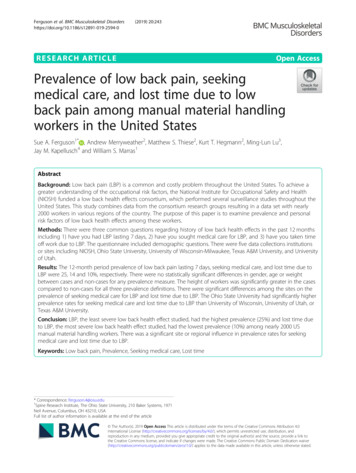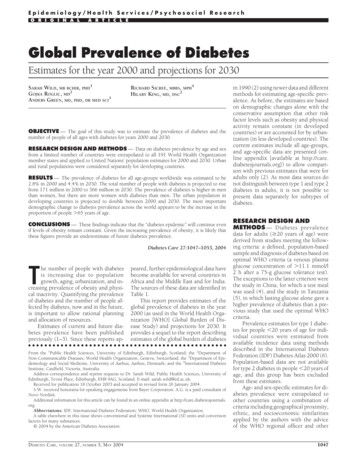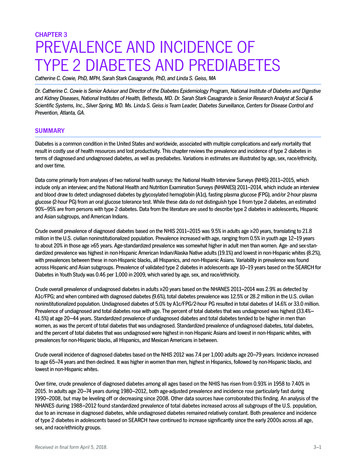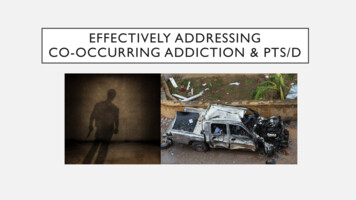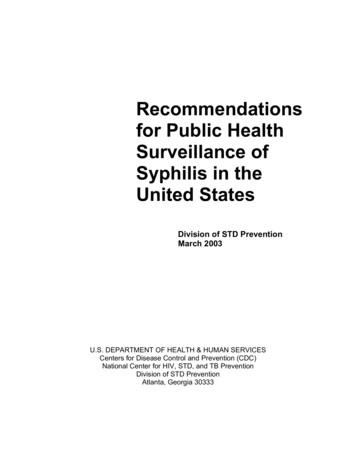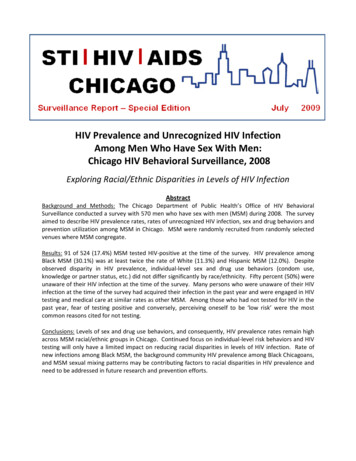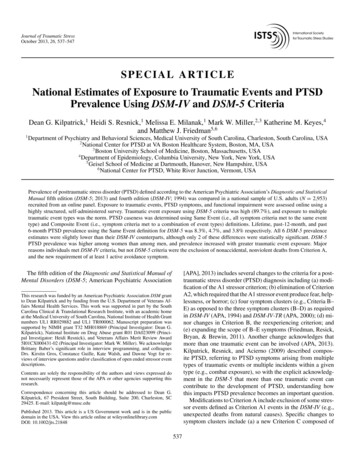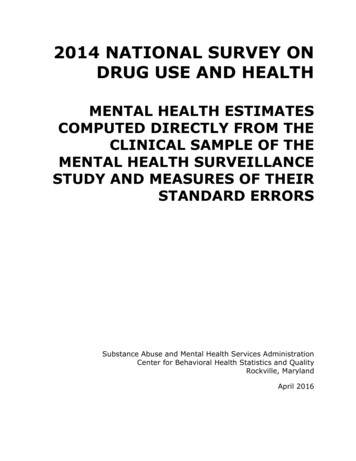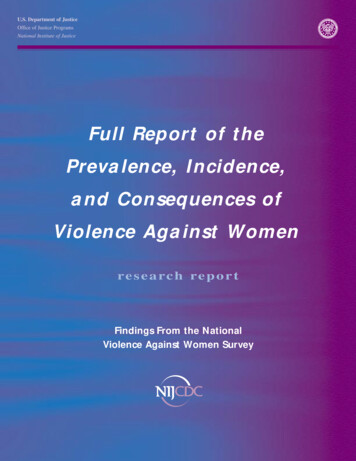
Transcription
U.S. Department of JusticeOffice of Justice ProgramsNational Institute of JusticeFull Report of thePrevalence, Incidence,and Consequences ofViolence Against Womenresearch reportFindings From the NationalViolence Against Women Survey
U.S. Department of JusticeOffice of Justice Programs810 Seventh Street N.W.Washington, DC 20531Janet RenoAttorney GeneralDaniel MarcusActing Associate Attorney GeneralMary Lou LearyActing Assistant Attorney GeneralJulie E. SamuelsActing Director, National Institute of JusticeOffice of Justice ProgramsWorld Wide Web Sitehttp://www.ojp.usdoj.govNational Institute of JusticeWorld Wide Web Sitehttp://www.ojp.usdoj.gov/nij
Full Report of thePrevalence, Incidence,and Consequences of ViolenceAgainst WomenPatricia TjadenNancy ThoennesFindings From the NationalViolence Against Women SurveyNovember 2000NCJ 183781
CENTERS FOR DISEASE CONTROLAND PREVENTIONJulie E. SamuelsActing Director, National Institute of JusticeStephen B. ThackerActing Director, National Center for Injury Prevention and ControlThis research was sponsored under award number 93–IJ–CX–0012 by the National Institute of Justice, Office ofJustice Programs, U.S. Department of Justice, and the Centers for Disease Control and Prevention. Findings andconclusions of the research presented here are those of the authors and do not necessarily reflect the official positionor policies of the U.S. Department of Justice.The National Institute of Justice is a component of the Office of Justice Programs, which also includes theBureau of Justice Assistance, the Bureau of Justice Statistics, the Office of Juvenile Justice and DelinquencyPrevention, and the Office for Victims of Crime.
iiiExecutive SummaryKey IssuesResearch on violence against women has exploded in the past 20 years, particularly in theareas of intimate partner violence and sexualassault. Despite this outpouring of research,many gaps exist in our understanding of violence against women. For instance, reliableinformation on minority women’s experienceswith violence is still lacking. Few empiricaldata exist on the relationship between differentforms of violence against women, such asvictimization in childhood and subsequentvictimization. Finally, empirical data on theconsequences of violence against women, including their injury rates and use of medicalservices, are lacking.To further understanding of violence againstwomen, the National Institute of Justice andthe Centers for Disease Control and Preventionjointly sponsored, through a grant to the Center for Policy Research, a national survey thatwas conducted from November 1995 to May1996. The National Violence Against Women(NVAW) Survey sampled both women andmen and thus provides comparable data onwomen’s and men’s experiences with violentvictimization.Respondents who disclosed that they had beenvictimized were asked detailed questions aboutthe characteristics and consequences of theirvictimization, including injuries they sustainedand their use of medical services.This NIJ Research Report presents findingsfrom the NVAW Survey on the prevalenceand incidence of rape, physical assault, andstalking; the rate of injury among rape andphysical assault victims; and injured victims’use of medical services. The data show thatviolence is more widespread and injurious towomen’s and men’s health than previouslythought—an important finding for legislators,policymakers, intervention planners, andresearchers as well as the public health andcriminal justice communities.Key FindingsAnalysis of survey data on the prevalence,incidence, and consequences of violenceagainst women produced the following results: Respondents to the survey were asked about: Physical assault they experienced as children by adult caretakers.Physical assault they experienced as adultsby any type of assailant.Forcible rape and stalking they experiencedat any time in their life by any type ofperpetrator. Physical assault is widespread among adultsin the United States: 51.9 percent of surveyedwomen and 66.4 percent of surveyed mensaid they were physically assaulted as a childby an adult caretaker and/or as an adult byany type of attacker. An estimated 1.9 millionwomen and 3.2 million men are physicallyassaulted annually in the United States.Many American women are raped at anearly age: Of the 17.6 percent of all womensurveyed who said they had been the victimof a completed or attempted rape at sometime in their life, 21.6 percent were youngerthan age 12 when they were first raped, and32.4 percent were ages 12 to 17. Thus, more
ivthan half (54 percent) of the female rapevictims identified by the survey wereyounger than age 18 when they experiencedtheir first attempted or completed rape. Stalking is more prevalent than previouslythought: 8.1 percent of surveyed women and2.2 percent of surveyed men reported beingstalked at some time in their life; 1.0 percentof women surveyed and 0.4 percent of mensurveyed reported being stalked in the 12months preceding the survey. Approximately 1 million women and 371,000 menare stalked annually in the United States.American Indian/Alaska Native womenand men report more violent victimizationthan do women and men of other racialbackgrounds: American Indian/AlaskaNative women were significantly morelikely than white women, African-Americanwomen, or mixed-race women to report theywere raped. They also were significantlymore likely than white women or AfricanAmerican women to report they were stalked.American Indian/Alaska Native men weresignificantly more likely than Asian men toreport they were physically assaulted. Rape prevalence varies between Hispanicand non-Hispanic women: Hispanic womenwere significantly less likely than nonHispanic women to report they were rapedat some time in their life.There is a relationship between victimization as a minor and subsequent victimization: Women who reported they were rapedbefore age 18 were twice as likely to reportbeing raped as an adult. Women who reported they were physically assaulted as achild by an adult caretaker were twice aslikely to report being physically assaultedas an adult. Women who reported they werestalked before age 18 were seven timesmore likely to report being stalked as anadult. Women experience more intimate partnerviolence than do men: 22.1 percent of surveyed women, compared with 7.4 percentof surveyed men, reported they were physically assaulted by a current or formerspouse, cohabiting partner, boyfriend orgirlfriend, or date in their lifetime; 1.3 percent of surveyed women and 0.9 percent ofsurveyed men reported experiencing suchviolence in the previous 12 months. Approximately 1.3 million women and 835,000men are physically assaulted by an intimatepartner annually in the United States.Violence against women is primarily intimate partner violence: 64.0 percent of thewomen who reported being raped, physically assaulted, and/or stalked since age18 were victimized by a current or formerhusband, cohabiting partner, boyfriend, ordate. In comparison, only 16.2 percent ofthe men who reported being raped and/orphysically assaulted since age 18 werevictimized by such a perpetrator.Women are significantly more likely thanmen to be injured during an assault: 31.5percent of female rape victims, comparedwith 16.1 percent of male rape victims,reported being injured during their mostrecent rape; 39.0 percent of female physicalassault victims, compared with 24.8 percentof male physical assault victims, reportedbeing injured during their most recentphysical assault.The risk of injury increases among femalerape and physical assault victims whentheir assailant is a current or former intimate: Women who were raped or physically assaulted by a current or formerspouse, cohabiting partner, boyfriend, ordate were significantly more likely thanwomen who were raped or physically assaulted by other types of perpetrators to report being injured during their most recentrape or physical assault.
v Approximately one-third of injured femalerape and physical assault victims receivemedical treatment: 35.6 percent of thewomen injured during their most recentrape and 30.2 percent of the women injuredduring their most recent physical assaultreceived medical treatment.Policy ImplicationsInformation generated by the NVAW Surveyvalidates opinions held by professionals inthe field about the pervasiveness and injuriousconsequences of violence against women.This study’s findings on the frequency withwhich women are victimized by intimate partners confirms previous reports that violenceagainst women is primarily intimate partnerviolence. The study makes it clear that violenceagainst women, particularly intimate partnerviolence, should be classified as a major publichealth and criminal justice concern in theUnited States. The large number of rape, physi-cal assault, and stalking victimizations committed against women each year and the earlyage at which violence starts for many womenstrongly suggest that violence against women isendemic. Because most victimizations are perpetrated against women by current and formerintimates and because women are more likelyto be injured if their assailant is a current orformer intimate, violence prevention strategiesfor women that focus on how they can protectthemselves from intimate partners are needed.Injury and medical utilization data provide compelling evidence of the physical and social costsassociated with violence against women. Thefindings suggest that future researchers shouldpay greater attention to demographic, social,and environmental factors that may accountfor variations in victimization rates amongwomen of different racial and ethnic backgrounds and to the link between victimizationthey experience as a minor and subsequentvictimization.
viOther Publications From the National Violence Against Women SurveyOther NIJ publications provide additional information on the National Violence AgainstWomen Survey: Stalking in America: Findings From theNational Violence Against Women Survey, Research in Brief, by Patricia Tjaden and NancyThoennes, Washington, DC: U.S. Departmentof Justice, National Institute of Justice, 1998,NCJ 169592. This document provides detailedinformation from the survey on women’s andmen’s experiences with stalking.Prevalence, Incidence, and Consequences ofViolence Against Women: Findings From theNational Violence Against Women Survey, Research in Brief, by Patricia Tjaden and NancyThoennes, Washington, DC: U.S. Departmentof Justice, National Institute of Justice, 1998,NCJ 172837. This document summarizes thefindings presented in this Research Report.Extent, Nature, and Consequences of IntimatePartner Violence: Findings From the NationalViolence Against Women Survey, ResearchReport, by Patricia Tjaden and NancyThoennes, Washington, DC: U.S. Department of Justice, National Institute of Justice,2000, NCJ 181867. This document providesdetailed information from the survey onwomen’s and men’s experiences withintimate partner violence.To obtain copies of these publications, visitNIJ’s Web site at: http://www.ojp.usdoj.gov/nij,or contact the National Criminal Justice Reference Service, P.O. Box 6000, Rockville, MD20849–6000; 800–851–3420 or 301–519–5500;or send an e-mail message to askncjrs@ncjrs.org.The following journal articles have been or willbe published about the NVAW Survey: Patricia Tjaden and Nancy Thoennes, “CoWorker Violence and Gender: Findings Fromthe National Violence Against Women Survey,” American Journal of Preventive Medicine, Special Edition on Workplace Violence,Vol. 20, Issue 1 (forthcoming 2001). Patricia Tjaden and Nancy Thoennes,“Effects of Interviewer Gender on Men’sResponses to a Telephone Survey on ViolentVictimization,” Journal of QuantitativeCriminology (forthcoming 2001). Patricia Tjaden, Nancy Thoennes, and Christine Allison, “Comparing Stalking Victimization from Legal and Victim Perspectives,”Violence and Victims, Vol. 15, No. 1 (2000):1–16. Patricia Tjaden and Nancy Thoennes,“Prevalence and Incidence of ViolenceAgainst Women: Findings from the NationalViolence Against Women Survey,” TheCriminologist, Vol. 24, No. 3, (May/June1999): 1, 4, 13–14. Patricia Tjaden and Nancy Thoennes,“Prevalence and Consequences of Male-toFemale and Female-to-Male Partner Violence as Measured by the National ViolenceAgainst Women Survey,” Violence AgainstWomen, Vol. 6, No. 2 (February 2000):142–161. Patricia Tjaden, Nancy Thoennes, ChristineAllison, “Comparing Violence Over theLifespan in Samples of Same-Sex andOpposite-Sex Cohabitants,” Violence andVictims, Vol. 14, No. 4 (1999): 413–425.National Violence Against Women SurveyMethodology Report by Patricia Tjaden,Steve Leadbetter, John Boyle, and Robert A.Bardwell provides a more detailed account ofthe survey methods. This document is underreview at the Centers for Disease Control andPrevention (CDC).To learn about CDC prevention activities related to family violence and intimate partnerviolence, visit CDC’s National Center forInjury Prevention and Control Web site athttp://www.cdc.gov/ncipc/dvp/fivpt.
viiAcknowledgmentsThe National Violence Against Women Surveywas supported by a grant to the Center forPolicy Research from the U.S. Department ofJustice’s National Institute of Justice and theU.S. Department of Health and HumanService’s Centers for Disease Control andPrevention. The authors thank Lois Mockat the National Institute of Justice and LindaSaltzman at the Centers for Disease Controland Prevention for their advice and supportin completing this project. The authors alsothank Holly Johnson at Statistics Canada andKirk Williams at the University of Colorado’sCenter for the Study and Prevention of Violencefor their help with the survey design. Finally,the authors thank Marcie-jo Kresnow, mathematical statistician at the Centers for DiseaseControl and Prevention, for her thorough reviewand helpful comments on drafts of the report.
ixContentsExecutive Summary . . . . . . . . . . . . . . . . . . . . . . . . . . . . . . . . . . . . . . . . . . . . . . . . . . . . . . . . . . . iiiAcknowledgments . . . . . . . . . . . . . . . . . . . . . . . . . . . . . . . . . . . . . . . . . . . . . . . . . . . . . . . . . . . . vii1. Survey Background . . . . . . . . . . . . . . . . . . . . . . . . . . . . . . . . . . . . . . . . . . . . . . . . . . . . . . . . . 12. Survey Methods . . . . . . . . . . . . . . . . . . . . . . . . . . . . . . . . . . . . . . . . . . . . . . . . . . . . . . . . . . . . 3Generating the Sample . . . . . . . . . . . . . . . . . . . . . . . . . . . . . . . . . . . . . . . . . . . . . . . . . . . . . . . . 3Conducting the Interviews . . . . . . . . . . . . . . . . . . . . . . . . . . . . . . . . . . . . . . . . . . . . . . . . . . . . . 3Survey Screening Questions . . . . . . . . . . . . . . . . . . . . . . . . . . . . . . . . . . . . . . . . . . . . . . . . . . . . 4Data Analysis . . . . . . . . . . . . . . . . . . . . . . . . . . . . . . . . . . . . . . . . . . . . . . . . . . . . . . . . . . . . . . . 6Precision of Sample Estimates . . . . . . . . . . . . . . . . . . . . . . . . . . . . . . . . . . . . . . . . . . . . . . . . . . 8Characteristics of the Sample and Sample Weighting . . . . . . . . . . . . . . . . . . . . . . . . . . . . . . . . 8Minimizing the Potential for Harming Respondents . . . . . . . . . . . . . . . . . . . . . . . . . . . . . . . . . 8Limitations of Telephone Surveys . . . . . . . . . . . . . . . . . . . . . . . . . . . . . . . . . . . . . . . . . . . . . . 113. Prevalence and Incidence of Rape, Physical Assault, and Stalking . . . . . . . . . . . . . . . . . .Prevalence and Incidence of Rape . . . . . . . . . . . . . . . . . . . . . . . . . . . . . . . . . . . . . . . . . . . . . .Prevalence and Incidence of Physical Assault . . . . . . . . . . . . . . . . . . . . . . . . . . . . . . . . . . . . .Rates of Physical Assault Among Rape Victims . . . . . . . . . . . . . . . . . . . . . . . . . . . . . . . . . . .Prevalence and Incidence of Stalking . . . . . . . . . . . . . . . . . . . . . . . . . . . . . . . . . . . . . . . . . . . .13131617184. Risk of Violence Among Racial Minorities and Hispanics . . . . . . . . . . . . . . . . . . . . . . . . .Prevalence of Violence Among Whites and Nonwhites . . . . . . . . . . . . . . . . . . . . . . . . . . . . .Prevalence of Violence Among Specific Racial Minorities . . . . . . . . . . . . . . . . . . . . . . . . . . .Prevalence of Violence Among Hispanics and Non-Hispanics . . . . . . . . . . . . . . . . . . . . . . . .212121235. Women’s and Men’s Risk of Intimate Partner Violence . . . . . . . . . . . . . . . . . . . . . . . . . .Prevalence and Incidence of Intimate Partner Violence . . . . . . . . . . . . . . . . . . . . . . . . . . . . . .Comparison With Previous Research . . . . . . . . . . . . . . . . . . . . . . . . . . . . . . . . . . . . . . . . . . . .Deciphering Disparities in Survey Findings . . . . . . . . . . . . . . . . . . . . . . . . . . . . . . . . . . . . . . .252528306. Violence Experienced as a Minor . . . . . . . . . . . . . . . . . . . . . . . . . . . . . . . . . . . . . . . . . . . . .Prevalence of Violence in Childhood and Adolescence . . . . . . . . . . . . . . . . . . . . . . . . . . . . . .Rape Experienced as a Minor . . . . . . . . . . . . . . . . . . . . . . . . . . . . . . . . . . . . . . . . . . . . . . . . . .Physical Assault by an Adult Caretaker . . . . . . . . . . . . . . . . . . . . . . . . . . . . . . . . . . . . . . . . . .Stalking Before Age 18 . . . . . . . . . . . . . . . . . . . . . . . . . . . . . . . . . . . . . . . . . . . . . . . . . . . . . .Relationship Between Victimization as a Minor and Subsequent Victimization . . . . . . . . . . .353535363839
x7. Violence Experienced as an Adult . . . . . . . . . . . . . . . . . . . . . . . . . . . . . . . . . . . . . . . . . . . . .Prevalence of Violence Experienced as an Adult . . . . . . . . . . . . . . . . . . . . . . . . . . . . . . . . . . .Rape Experienced as an Adult . . . . . . . . . . . . . . . . . . . . . . . . . . . . . . . . . . . . . . . . . . . . . . . . .Physical Assault Experienced as an Adult . . . . . . . . . . . . . . . . . . . . . . . . . . . . . . . . . . . . . . . .Stalking Experienced as an Adult . . . . . . . . . . . . . . . . . . . . . . . . . . . . . . . . . . . . . . . . . . . . . . .Violence Against Women Is Predominantly Intimate Partner Violence . . . . . . . . . . . . . . . . .Violence Against Women and Men Is Predominantly Male Violence . . . . . . . . . . . . . . . . . .434343434546468. Physical Injury and Use of Medical Services . . . . . . . . . . . . . . . . . . . . . . . . . . . . . . . . . . . .Rates of Injury Among Rape and Physical Assault Victims . . . . . . . . . . . . . . . . . . . . . . . . . .Risk Factors Associated With Violence-Related Injury . . . . . . . . . . . . . . . . . . . . . . . . . . . . . .Injured Victims’ Use of Medical Services . . . . . . . . . . . . . . . . . . . . . . . . . . . . . . . . . . . . . . . .Annual Health Care Utilization Estimates for Rape and Physical Assault Victims . . . . . . . . .Rates of Violence-Related Injury and Accidental Injury . . . . . . . . . . . . . . . . . . . . . . . . . . . . .4949505456579. Policy Implications . . . . . . . . . . . . . . . . . . . . . . . . . . . . . . . . . . . . . . . . . . . . . . . . . . . . . . . . . 59
xiExhibitsExhibit 1.Estimated Standard Errors Multiplied by the Z-Score (1.96) for a95-Percent Confidence Level by Sample or Subsample SizeExhibit 2.Comparison of Demographic Characteristics of NVAW SurveySample and U.S. PopulationExhibit 3.Persons Victimized in Lifetime by Type of Victimization and Victim GenderExhibit 4.Persons Victimized in Previous 12 Months by Type of Victimizationand Victim GenderExhibit 5.Estimated Number of Rape, Physical Assault, and StalkingVictimizations Perpetrated Annually by Victim GenderExhibit 6.Persons Victimized in Lifetime by Type of Victimization, Victim Gender,and White/Nonwhite Status of VictimExhibit 7.Persons Victimized in Lifetime by Type of Victimization, VictimGender, and RaceExhibit 8.Persons Victimized in Lifetime by Type of Victimization, Victim Gender,and Hispanic/Non-Hispanic OriginExhibit 9.Persons Victimized by an Intimate Partner in Lifetime and Previous12 Months by Type of VictimizationExhibit 10.Estimated Number of Rape, Physical Assault, and Stalking VictimizationsPerpetrated by Intimate Partners Annually by Victim GenderExhibit 11.Persons Physically Assaulted by an Intimate Partner in Lifetime by Typeof Assault and Victim GenderExhibit 12.Persons Victimized Before Age 18 by Type of Victimization and Victim GenderExhibit 13.Percentage Distribution of Rape Victims by Age at Time of First Rapeand Victim GenderExhibit 14.Percentage Distribution of Child and Adolescent Rape Victims by Victim-PerpetratorRelationship and Victim GenderExhibit 15.Persons Physically Assaulted as a Child by an Adult Caretaker byType of Assault and Victim Gender
xiiExhibit 16.Percentage Distribution of Stalking Victims by Age at Time of FirstStalking and Victim GenderExhibit 17.Percentage Distribution of Child and Adolescent Stalking Victims byVictim-Perpetrator Relationship: Female Victims Only (n 71)Exhibit 18.Women Raped as an Adult by Whether They Were Raped/NotRaped as a MinorExhibit 19.Persons Physically Assaulted as an Adult by Whether They WerePhysically Assaulted/Not Physically Assaulted as a Minor and Victim GenderExhibit 20.Women Stalked as an Adult by Whether They Were Stalked/NotStalked as a MinorExhibit 21.Persons Victimized Since Age 18 by Type of Victimization and Victim GenderExhibit 22.Percentage Distribution of Adult Female Rape Victims by Victim-PerpetratorRelationship (n 767)Exhibit 23.Persons Physically Assaulted Since Age 18 by Type of Assault and Victim GenderExhibit 24.Percentage Distribution of Adult Physical Assault Victims by Victim-PerpetratorRelationship and Victim GenderExhibit 25.Percentage Distribution of Adult Stalking Victims by Victim-PerpetratorRelationship and Victim GenderExhibit 26.Percentage Distribution of Adult Victims of Violence by Victim-PerpetratorRelationship and Victim Gender: All Types of VictimizationExhibit 27.Percentage Distribution of Adult Rape and Physical Assault Victims byVictim-Perpetrator Relationship and Victim GenderExhibit 28.Percentage Distribution of Adult Female Victims by Type of Victimizationand Perpetrator GenderExhibit 29.Percentage Distribution of Adult Male Victims by Type of Victimization andPerpetrator GenderExhibit 30.Percentage Distribution of Adult Rape and Physical Assault Victims byWhether Victim Was Injured and Victim GenderExhibit 31.Percentage of Injured Adult Rape and Physical Assault Victims WhoSustained Specific Types of Injuries: Men and Women CombinedExhibit 32.Rape and Physical Assault Victims Who Were Injured by Characteristicsof the Victimization and Victim Gender
xiiiExhibit 33.Percentage Distribution of Injured Rape and Physical Assault Victims byType of Medical Care Received and Victim GenderExhibit 34.Average Number of Medical Care Visits for Rape and Physical AssaultVictims by Type of Medical Care and Victim GenderExhibit 35.Average Annual Injury and Medical Utilization Estimates for AdultRape and Physical Assault Victims by Victim Gender
11. Survey BackgroundViolence against women first came to be viewedas a serious social problem in the early 1970s,in part because of the re-emergence of thewomen’s movement.1 In unprecedented numbers,scholars trained in such diverse disciplines as philosophy, literature, law, and sociology examinedviolence against women in the context of a feminist ideology.2 Despite the resulting outpouring ofresearch on violence against women, particularlyin the areas of rape and intimate partner violence,many gaps remain.3Until now, for instance, empirical data on therelationship between childhood victimizationand subsequent victimization were lacking.Reliable information on minority women’sexperiences with violence also was limited. Inaddition, reliable data on the consequences ofviolence against women, including their injuryrates and use of medical services, were limited.4To further an understanding of violence againstwomen, the Centers for Disease Control andPrevention (CDC) and the National Institute ofJustice (NIJ) jointly sponsored—through a grantto the Center for Policy Research—a nationaltelephone survey on women’s experiences withviolence, conducted from November 1995 toMay 1996. The National Violence AgainstWomen (NVAW) Survey consisted of interviewswith both women and men, thus providing comparable data on women’s and men’s experienceswith violent victimization.NVAW Survey respondents were queried abouta wide range of topics, including: Physical assault they experienced as childrenby adult caretakers.Physical assault they experienced as adults byany type of assailant.Unique Features of the National Violence Against Women SurveySeveral features of the NVAW Survey set it apartfrom other victimization surveys: State-of-the-art techniques protected theconfidentiality of the information being gatheredand minimized the potential for retraumatizingvictims of violence and jeopardizing the safetyof respondents. In addition to lessening the possibility that respondents would be harmed as aresult of their participation in the survey, thesetechniques were likely to have improved thequality of the information being gathered.Information about both the prevalence (lifetimeand annual) and incidence of violence wasgathered. Victimization estimates from theNVAW Survey can be compared with victimization estimates from many other surveys. Multiple, behaviorally specific questions(rather than single, direct questions) wereused to screen respondents for rape, physicalassault, and stalking victimization. These questions were designed to leave little doubt in therespondent’s mind as to the type of informationbeing sought. Detailed information about the characteristicsand consequences of victimization for eachtype of perpetrator identified by the respondentwas gathered. Although this approach createda very complicated dataset, it also created theopportunity to track victimizations by the sameperpetrator (e.g., the victim’s first formerhusband).
2 Forcible rape and stalking they experiencedat any time in their life by any type ofperpetrator.Respondents who disclosed that they had beenvictimized were asked detailed questions aboutthe characteristics and consequences of theirvictimization, including injuries they sustainedand their use of medical services.This NIJ Research Report summarizes the survey’sfindings on the prevalence and incidence of rape,physical assault, and stalking; the prevalenceof rape, physical assault, and stalking amongwomen and men of different racial backgroundsand between women and men of Hispanic andnon-Hispanic origin; the prevalence of male-tofemale and female-to-male intimate partner violence; the relationship between victimization asa minor and subsequent victimization; the rate ofinjury among rape and physical assault victims;and injured victims’ use of medical services.A condensed version of this report has beenpreviously published and is available throughthe National Institute of Justice’s Research inBrief series. (See “Other Publications From theNational Violence Against Women Survey” inthe Executive Summary.)Notes1. Kennedy, L.W., in Foreword to Dangerous Domains: Violence Against Women in Canada by HollyJohnson, Scarborough, Ontario: International Thomas Publishing, 1996.2. Wilson, C.F., Violence Against Women: An Annotated Bibliography, Boston: G.K. Hall & Co., 1981.3. National Research Council, Understanding Violence Against Women, Washington, DC: NationalAcademy Press, 1996: 40–44.4. Ibid.
32. Survey MethodsThe National Violence Against Women (NVAW)Survey was conducted from November 1995 toMay 1996 by interviewers at Schulman, Ronca,Bucuvalas, Inc. (SRBI) under the direction ofJohn Boyle.1 The authors of this report designedthe survey, edited the data, and conducted theanalysis.Physical assault by adult caretakers experienced as children.The NVAW Survey sample was drawn by randomdigit dialing (RDD) from households witha telephone in the 50 States and the District ofColumbia. The sample was administered by U.S.Census region. Within each region, a simplerandom sample of working residential “hundredbanks” of phone numbers was drawn. (A hundred bank is the first 8 digits of any 10-digittelephone number; e.g., 301–608–38XX). A randomly generated 2-digit number was appendedto each randomly sampled hundred bank toproduce the full 10-digit, random-digit number.Separate banks of numbers were generated formale and female respondents. These randomdigit numbers were called by SRBI interviewersfrom their central telephone facility in New YorkCity, where nonworking and nonresidentialnumbers (e.g., businesses, institutions, churches,halfway houses, and dormitories) were screenedout. Once a residential household was reached,eligible adults (i.e., women and men age 18 andolder) in each household were identified. Inhouseholds with more than one eligible adult,the adult with the most recent birthday wasselected as the designated respondent.Physical assault by other adults experiencedas adults.Conducting the InterviewsRespondents to the survey were queried about: Their level of concern about their personalsafety.Their marital and cohabiting relationshiphistory. Their sociodemographic characteristics. Their use of drugs and alcohol. Generating the SampleTheir general state of physical and mentalhealth.Their current partner’s sociodemographiccharacteristics.Emotional abuse by current and formerspouses and cohabiting partners.Forcible rape and stalking by any type ofperpetrator experienced at any time in theirlife.Respondents who disclosed victimization wereasked detailed questions about the characteri
United States. The large number of rape, physi-cal assault, and stalking victimizations com-mitted against women each year and the early age at which violence starts for many women strongly suggest that violence against women is endemic. Because most victimizations are per-petrated against women by current and former



